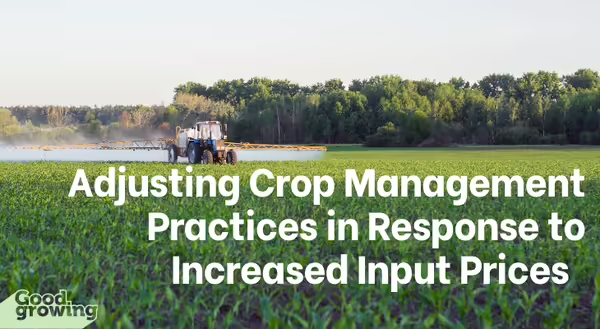
More and more, we hear of major supply chain issues in the United States that have affected pretty much everything. As farmers prepare for the 2022 growing season, they are experiencing fertilizer and herbicide shortages resulting in significant price increases. Higher input prices will likely affect management choices farmers make for the 2022 crop.
If you are not regularly soil sampling fields, fall of 2021 may be a great time to soil sample to know your current soil Phosphorus (P) and Potassium (K) levels. Soil test levels of 25 to 30 parts per million (ppm) of P and 150 to 175 ppm of K are considered adequate. If your P and K levels fall in or over the adequate range, lowering or skipping fertilizer application rates may be a cost saving option with high fertilizer prices. If your soil nutrient levels are lower than the adequate range, maintenance fertilizer applications rather than build-up applications may be a good option for this year. Maintenance application rates can be calculated with corn removal rates of 0.37 lb of P2O5 and 0.24 lb of K2O per bushel of harvested grain, and soybean removal rates of 0.75 lb of P2O5 and 1.17 lb of K2O per bushel.
With our P and K application rates figured out; what do we do about nitrogen? The Maximum Return to Nitrogen or MRTN should be used to figure out the most profitable N rate based on nitrogen and corn prices. Information provided by Precision Conservation Management (PCM) indicates that 67% of farmers apply nitrogen above MRTN rates; in addition to this information, PCM shows there is no economic gain from that additional nitrogen, so it should be very easy to scale our nitrogen applications back to MRTN rates to cut input costs (Sellars et. al.).
Other nitrogen cost-saving options include applying only part of your nitrogen in the fall with the hope that prices will fall in the spring. Obviously, this is a gamble as spring could bring even higher prices and limitations. Of the past 14 years, anhydrous ammonia prices were lower in April than October only 28% of the time (Schnitkey et al.). An advantage to spring application is that farmers can often apply less nitrogen as it is more likely to stay in place and will be taken up by the crop. Trials by the University of Illinois comparing fall and spring nitrogen application rates show an optimum fall rate 18 lbs higher than spring rates to account for loss (Nafziger). In a year where we may be putting out minimal nitrogen, we can’t afford to lose it.
With speculation of glyphosate and glufosinate shortages and increased cost, it is important to create a plan for a herbicide program to minimize impact to your farm. Some important things to remember when designing a new herbicide program include 1) consider the crop(s) that will be grown that season; if you grow cover crops, factor in any potential herbicide carryover effects on this crop too. 2) Utilize chemicals with residual activity to provide prolonged control of weeds. 3) Select varieties and hybrids with multiple herbicide-tolerant trait stacks to give yourself options for postemergence herbicide applications. Talk with your dealer to figure out what products are more readily available and fit into your cropping program.
Some other tips when it comes to working through glyphosate and glufosinate shortages, take note of fields with problem weeds. Is this a resistance issue from not switching up the site of action, were conditions not right during or after application, or is it a reoccurring issue? You may decide to save available glyphosate and glufosinate for any problematic acres. It is also important to be flexible about your source of glyphosate; many premixes contain glyphosate and would be an option to utilize the herbicide.
Good Growing Fact: There are no easy answers for farmers on what to do in response to rising input prices; however, there are many resources available to help aid in decision making. Check out University of Illinois farmdoc Daily to receive tools and data for making better decisions.
Resources
- Schnitkey, G., N. Paulson, K. Swanson and C. Zulauf. "Management Decisions Relative to High Nitrogen Fertilizer Prices." farmdoc daily (11):147, Department of Agricultural and Consumer Economics, University of Illinois at Urbana-Champaign, October 26, 2021.
- Sellars, S., G. Schnitkey, and L. Gentry. “Do Illinois Farmers Follow University-Based Nitrogen Recommendations?” 2020 Agricultural & Applied Economics Association Annual Meeting, Kansas City, MO, July 26-28, 2020.
- Nafziger, E. "Spring Nitrogen Management." Department of Crop Sciences, University of Illinois at Urbana-Champaign, April 13, 2017.
MEET THE AUTHOR
Katie Parker is a Local Foods and Small Farms Educator with University of Illinois Extension, serving Adams, Brown, Hancock, Pike, and Schuyler counties. Katie provides programming with an emphasis on row crop production, soil fertility, composting, vegetable production, and ornamental horticulture.
Signup for our emails! Want to get notified when new Good Growing posts are available? SIGN ME UP